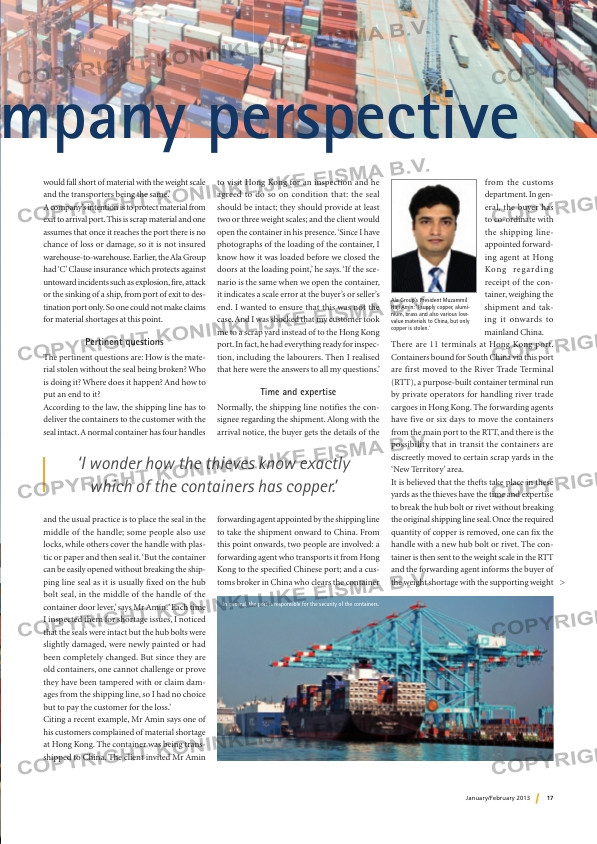Page 17 from: January / February 2013

17January/February 2013
would fall short of material with the weight scale
and the transporters being the same.’
A company’s intention is to protect material from
exit to arrival port. This is scrap material and one
assumes that once it reaches the port there is no
chance of loss or damage, so it is not insured
warehouse-to-warehouse. Earlier, the Ala Group
had ‘C’ Clause insurance which protects against
untoward incidents such as explosion, fire, attack
or the sinking of a ship, from port of exit to des-
tination port only. So one could not make claims
for material shortages at this point.
Pertinent questions
The pertinent questions are: How is the mate-
rial stolen without the seal being broken? Who
is doing it? Where does it happen? And how to
put an end to it?
According to the law, the shipping line has to
deliver the containers to the customer with the
seal intact. A normal container has four handles
and the usual practice is to place the seal in the
middle of the handle; some people also use
locks, while others cover the handle with plas-
tic or paper and then seal it. ‘But the container
can be easily opened without breaking the ship-
ping line seal as it is usually fixed on the hub
bolt seal, in the middle of the handle of the
container door lever,’ says Mr Amin. ‘Each time
I inspected them for shortage issues, I noticed
that the seals were intact but the hub bolts were
slightly damaged, were newly painted or had
been completely changed. But since they are
old containers, one cannot challenge or prove
they have been tampered with or claim dam-
ages from the shipping line, so I had no choice
but to pay the customer for the loss.’
Citing a recent example, Mr Amin says one of
his customers complained of material shortage
at Hong Kong. The container was being trans-
shipped to China. The client invited Mr Amin
to visit Hong Kong for an inspection and he
agreed to do so on condition that: the seal
should be intact; they should provide at least
two or three weight scales; and the client would
open the container in his presence. ‘Since I have
photographs of the loading of the container, I
know how it was loaded before we closed the
doors at the loading point,’ he says. ‘If the sce-
nario is the same when we open the container,
it indicates a scale error at the buyer’s or seller’s
end. I wanted to ensure that this was not the
case. And I was shocked that my customer took
me to a scrap yard instead of to the Hong Kong
port. In fact, he had everything ready for inspec-
tion, including the labourers. Then I realised
that here were the answers to all my questions.’
Time and expertise
Normally, the shipping line notifies the con-
signee regarding the shipment. Along with the
arrival notice, the buyer gets the details of the
forwarding agent appointed by the shipping line
to take the shipment onward to China. From
this point onwards, two people are involved: a
forwarding agent who transports it from Hong
Kong to the specified Chinese port; and a cus-
toms broker in China who clears the container
from the customs
department. In gen-
eral, the buyer has
to co-ordinate with
the shipping line-
appointed forward-
ing agent at Hong
Kong regarding
receipt of the con-
tainer, weighing the
shipment and tak-
ing it onwards to
mainland China.
There are 11 terminals at Hong Kong port.
Containers bound for South China via this port
are first moved to the River Trade Terminal
(RTT), a purpose-built container terminal run
by private operators for handling river trade
cargoes in Hong Kong. The forwarding agents
have five or six days to move the containers
from the main port to the RTT, and there is the
possibility that in transit the containers are
discreetly moved to certain scrap yards in the
‘New Territory’ area.
It is believed that the thefts take place in these
yards as the thieves have the time and expertise
to break the hub bolt or rivet without breaking
the original shipping line seal. Once the required
quantity of copper is removed, one can fix the
handle with a new hub bolt or rivet. The con-
tainer is then sent to the weight scale in the RTT
and the forwarding agent informs the buyer of
the weight shortage with the supporting weight >
Container theft: a company perspective
Ala Group’s President Muzammil
Haji Amin: ‘I supply copper, alumi-
nium, brass and also various low-
value materials to China, but only
copper is stolen.’
In general, the port is responsible for the security of the containers.
‘I wonder how the thieves know exactly
which of the containers has copper.’
RI_1-Container.indd 17 28-01-13 15:58



